1lumen selects and reviews products personally. We may earn affiliate commissions through our links, which help support our testing.
ThruNite Catapult Mini v2 review
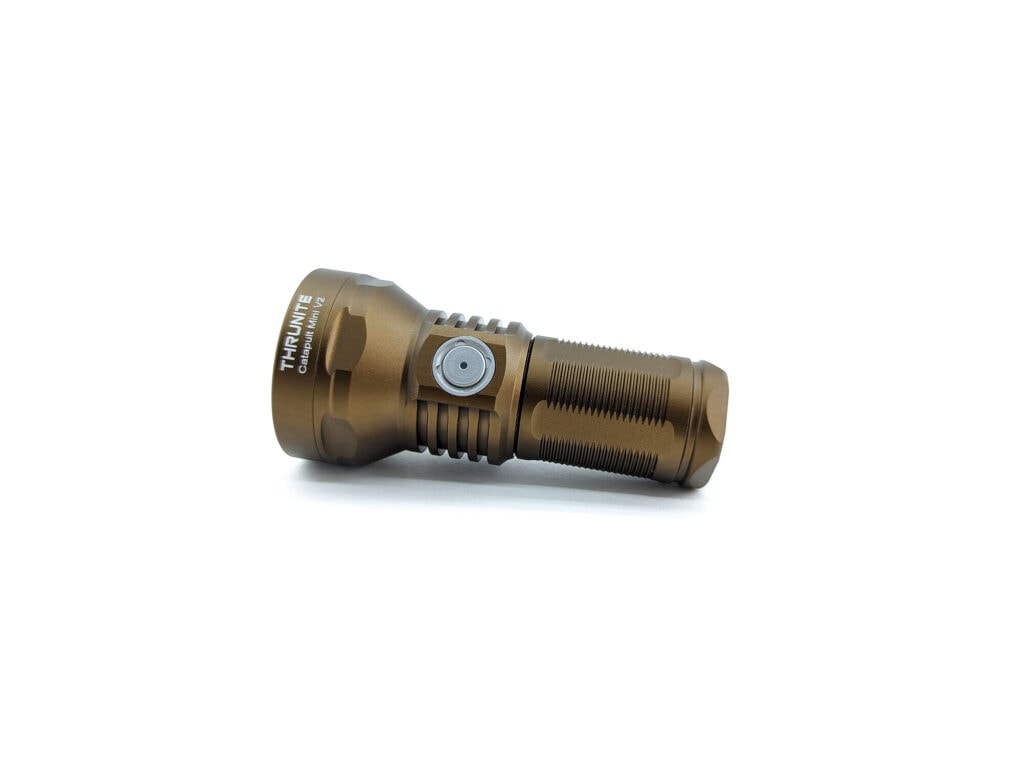
ThruNite Catapult Mini v2 specs
| Brand & Model | ThruNite Catapult Mini v2 |
|---|---|
| Flashlight category | Mini thrower / hunting |
| LED | Luminus SFT40 |
| Max. output | 1108 lumens |
| Max. beam distance | 515 meters |
| Max. beam intensity | 66,150 cd |
| Battery config. | 1x 18350 |
| Onboard charging | USB-C |
| Main modes | 5 |
| Blinkies | Strobe, Beacon, SOS |
| Waterproof | IPX8 |
| Review publication date | August 2023 |
Review intro:
ThruNite has been in operation since 2009 and has put out some very nice flashlights. In fact, my very first “nice” headlamp was a ThruNite TH20 which has served me faithfully for the past 5 years. I feel like ThruNite products sit in a comfortable “in between” segment: they’re not ultra-budget lights that skimp on features, but they usually don’t break the bank either. Overall, they provide a good mix of value and performance.
Up for review today is an update to the Catapult Mini, appropriately named the Catapult Mini V2. At first blush, this V2 looks very similar to the first generation. Upon closer inspection, you’ll notice some updates to the body styling, as well as the transition to a new LED and move from TIR to a reflector. So… that’s the short of it, but let’s really run the ThruNite Catapult Mini V2 through its paces!
The Catapult Mini V2 comes ready for business, aside from the fact that you need to tighten the head to the body before using it. So instead of using an isolation disc, ThruNite simply left the flashlight physically locked out and attached a tag saying so. Oh, and they also recommend charging it before using it.
Package quality.
The ThruNite Catapult Mini V2 arrived in pretty typical packaging: a brown cardboard box with some light ThruNite branding on the outside. The inside was lined with foam. Overall, pretty understated but highly functional in making sure the goods arrive in proper order. Inside the box was:
- ThruNite Catapult Mini V2
- 18350 battery
- Charging cable
- Lanyard
- Spare o-rings
- Spare USB cover
- Manual
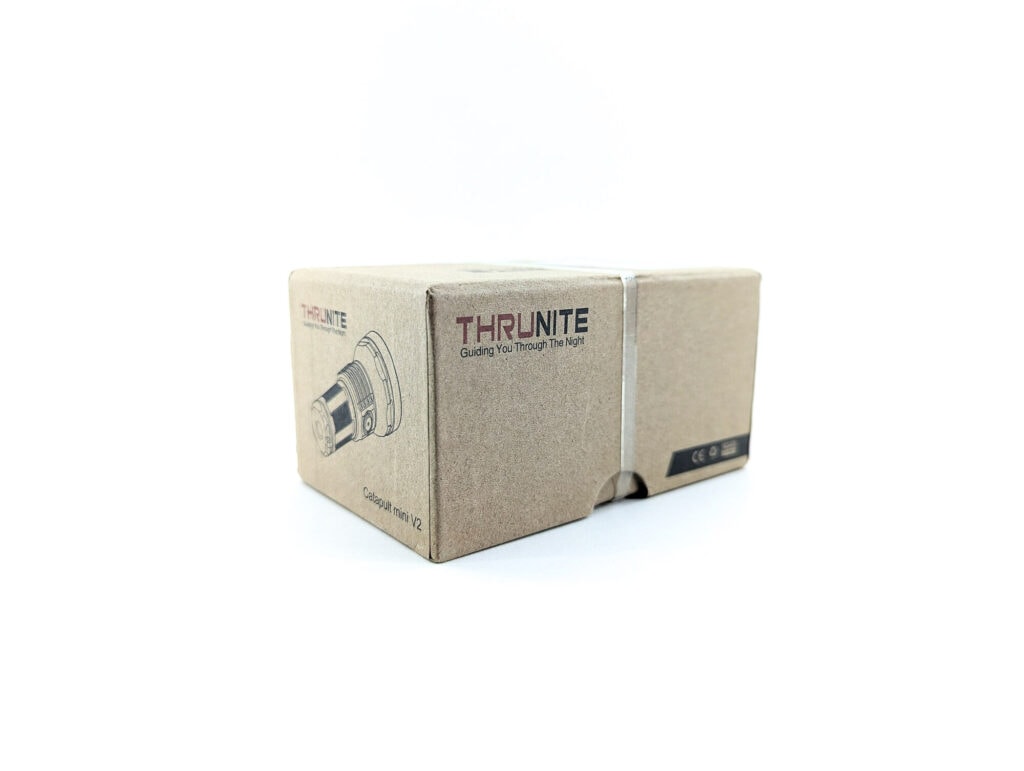
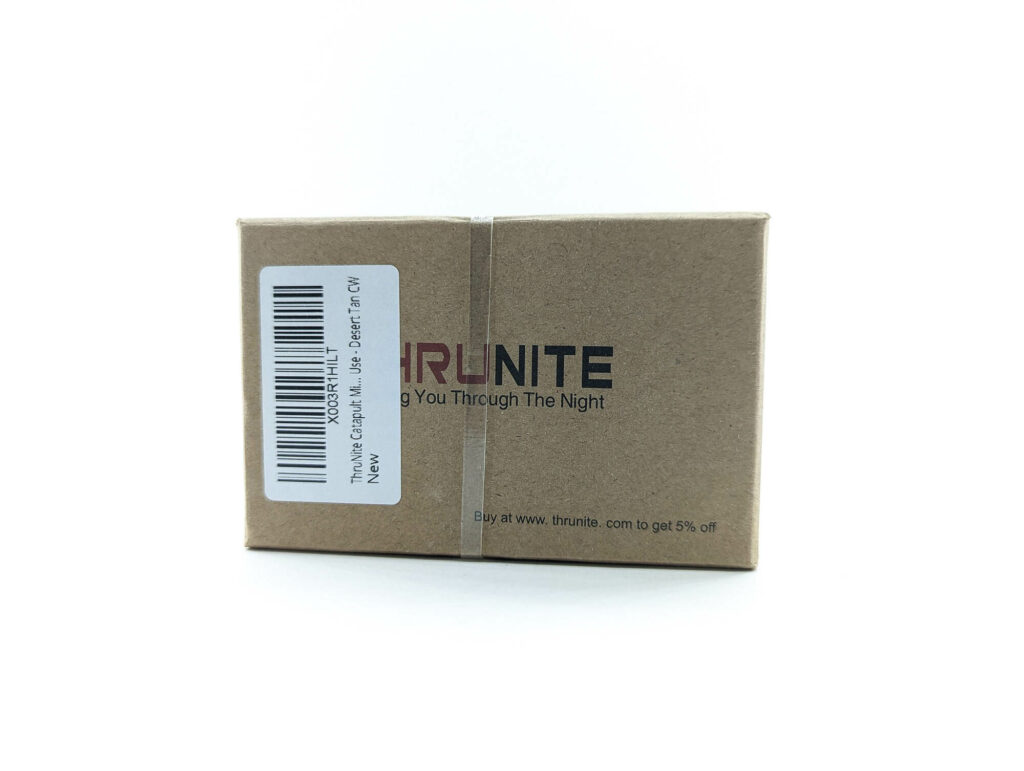
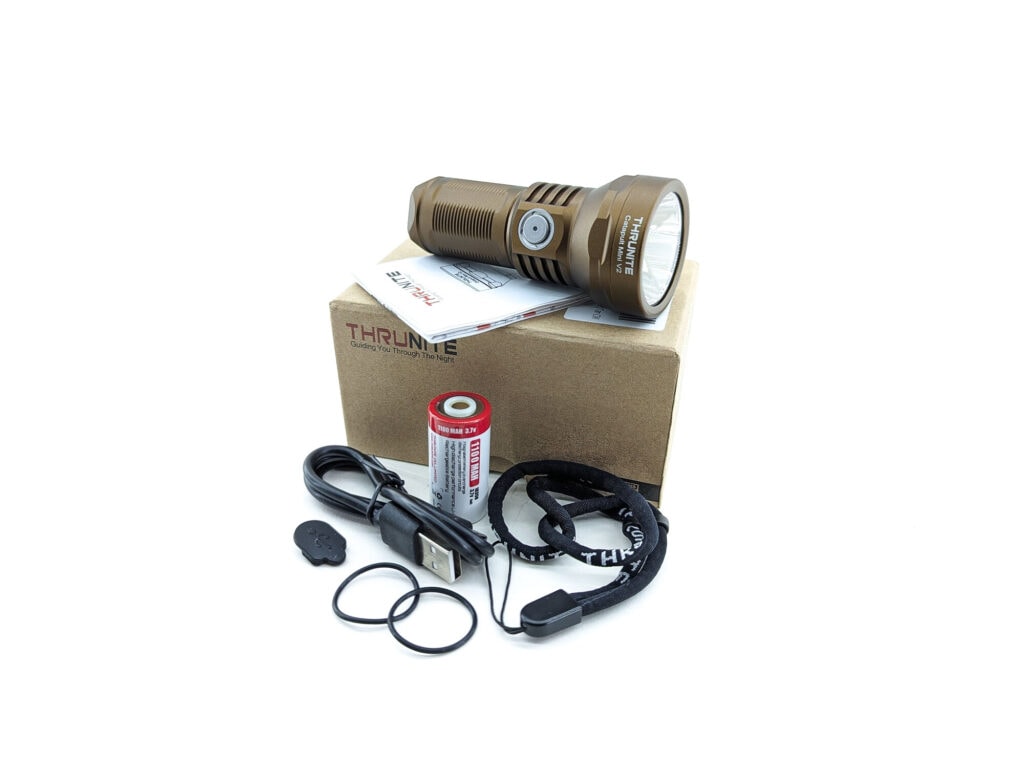
Flashlight in use
The ThruNite Catapult Mini v2 is definitely a mini-thrower. Being built around a 18350, it is small enough to fit in the palm of my (average sized) hand without hanging over. All of the edges are smoothed over. There’s no rough edges to be found, save for a little bit of sharpness around the lanyard hole. That seems (unfortunately) pretty common. Speaking of smooth, there is nothing to keep the Catapult Mini V2 from rolling around on a flat surface: no flats and no pocket clip. So keep an eye on it if that is a concern of yours. The tail is easily flat enough for stable tail-standing.
There are two flat, raised areas on the side of the head. The first is home to the USB-C charging port. The port is protected by a rubber cover that is flush with the raised area. The second flat is the location for the stainless steel switch button and ring. The button is slightly proud of the flat area: enough to aid in locating the button, but not enough to make accidental activation an issue. That said, the button is still a bit difficult to find without looking. Several times I found myself trying to press the USB cover.
When it comes to using the ThruNite Catapult Mini V2, it’s a fairly versatile little guy. The small size makes it pretty easy to pack along with you in a jacket pocket, or perhaps a pants pocket (as long as you’re not into skinny jeans, I suppose). This flashlight would be right at home going for walks, hiking, hunting, or scanning the backyard. With its proper moonlight/firefly mode, it’s not too shabby at low-light tasks, either. Being throwy, it wouldn’t be my first choice as a reading light, but it would work in a pinch.
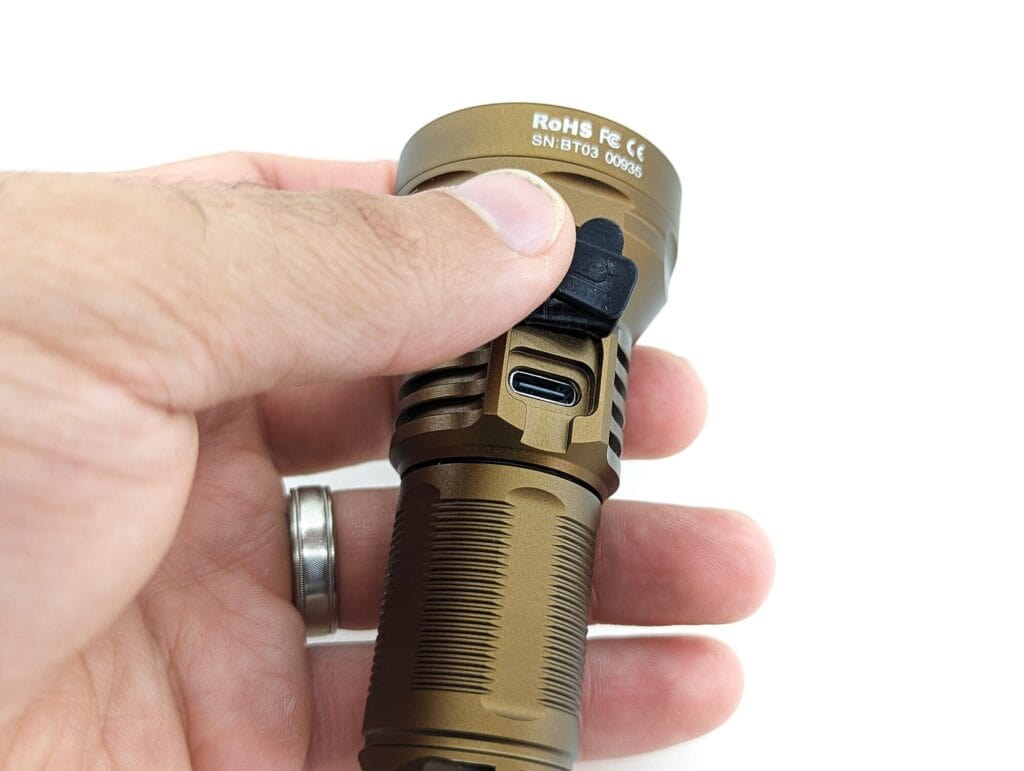
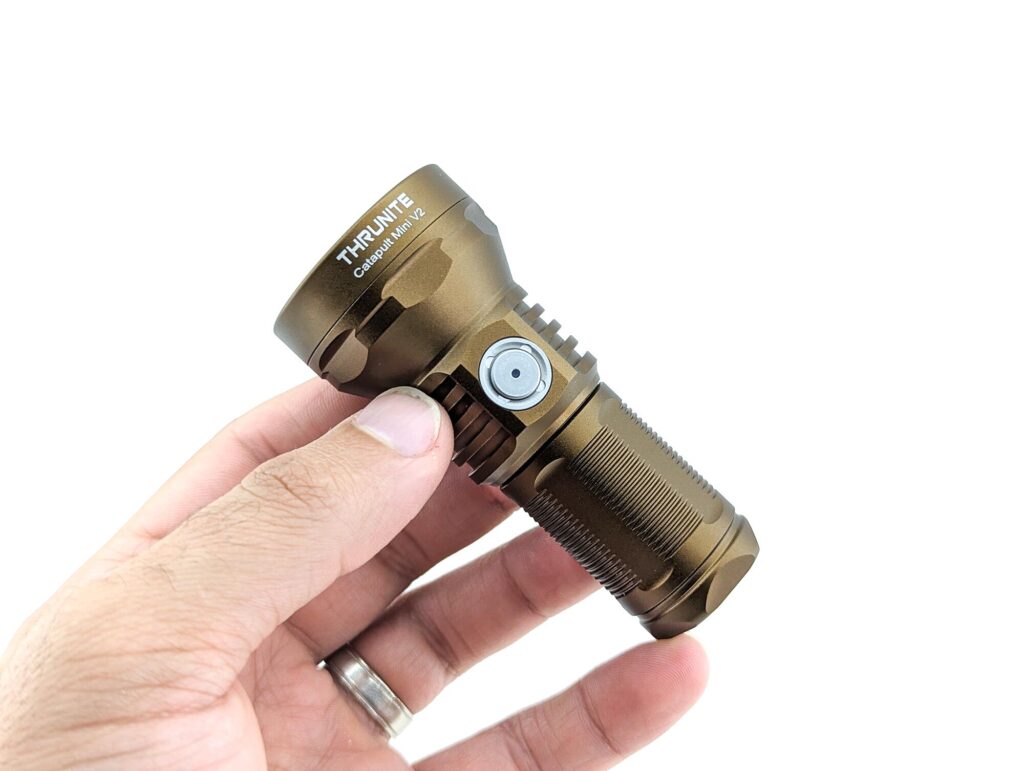
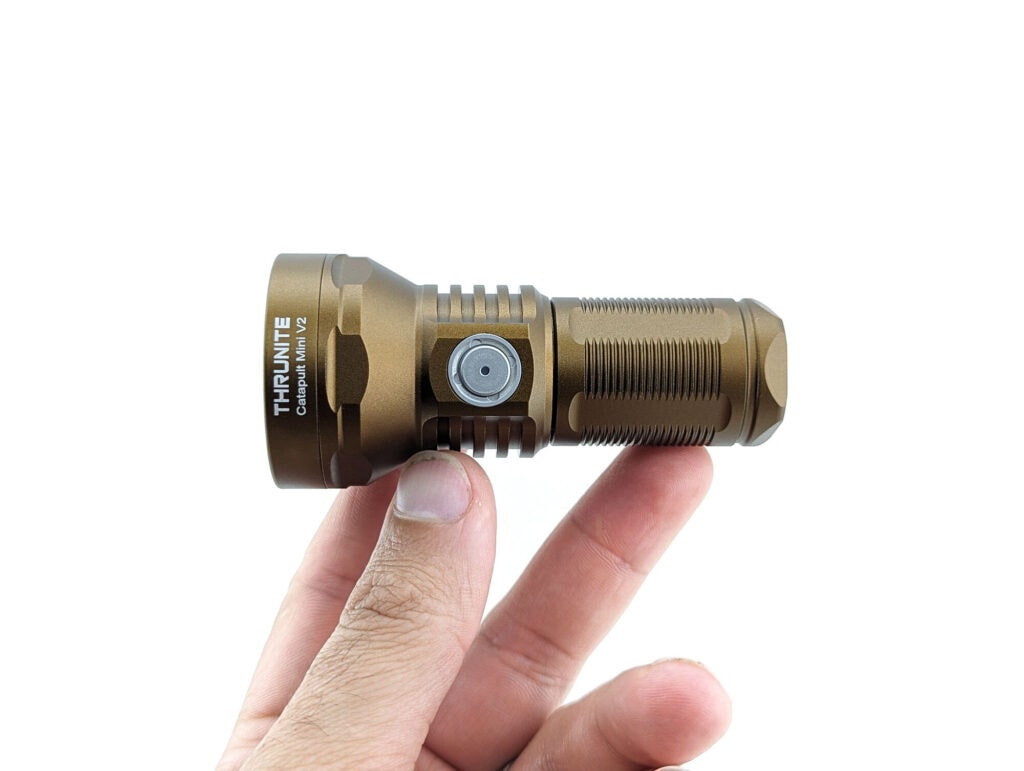
Build Quality and Warranty
The ThruNite Catapult Mini v2 is predominantly made out of 6061-T6 aluminum which is covered in premium Type III Hard-Anodized finish. I would say the Desert Tan coating has a “satin” sheen to it. The anodizing is very clean and even. The majority of the body tube is covered with fine rings that remind me of bolt threads with 5 flats ground along the tube. There is no traditional knurling. The body and tailcap are made from a single piece of aluminum, as best as I can tell.
I’ve alway been very pleased with ThruNite’s build quality, and this flashlight is no exception. The fit & finish feels a notch above the usual budget-minded brands.
Warranty:
- 30 days refund from Amazon (if you bought it on Amazon)
- 2 years free replacement from issues brought on by normal use
- Limited lifetime maintenance (cost of parts and shipping covered by the customer)
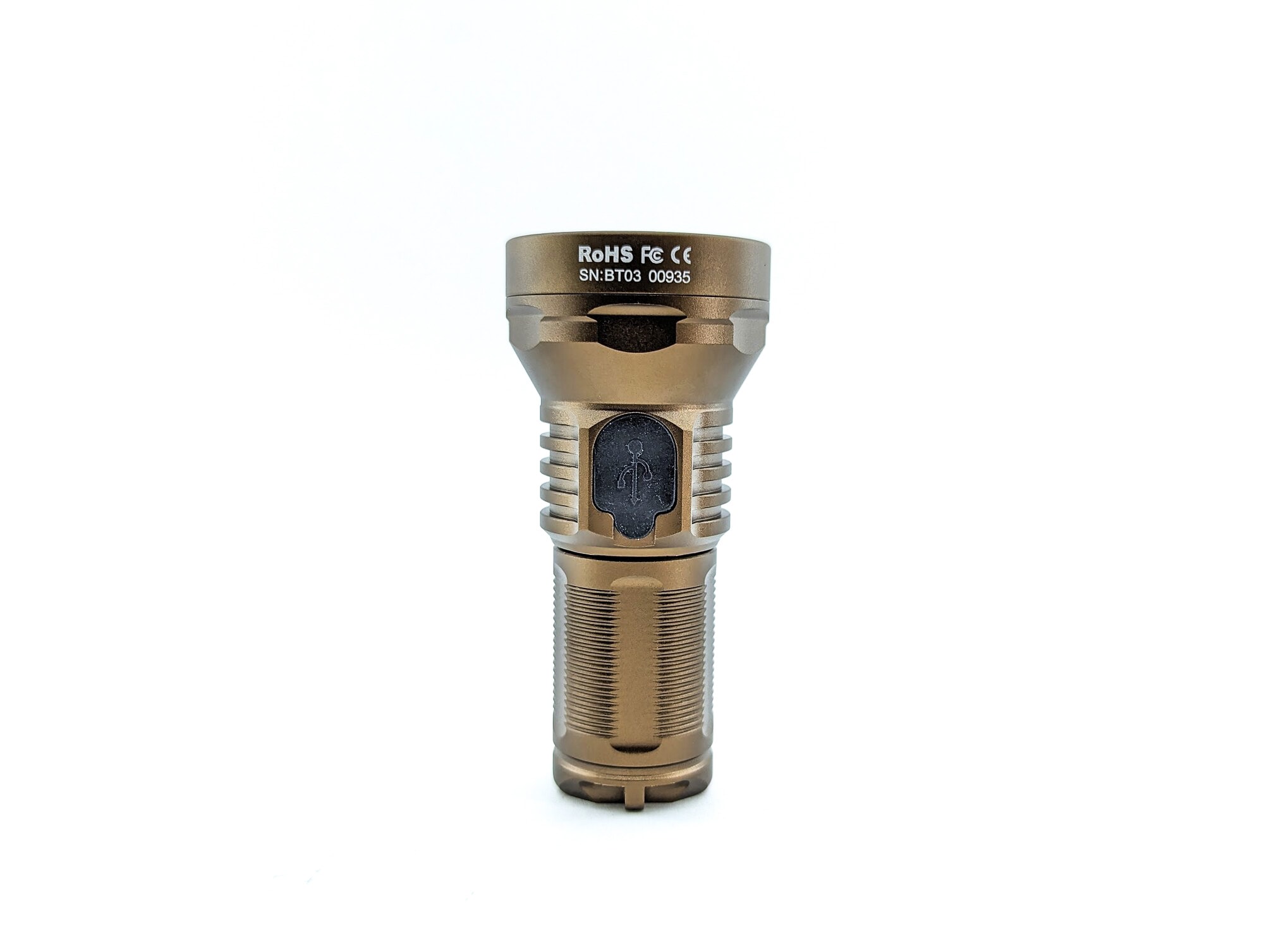
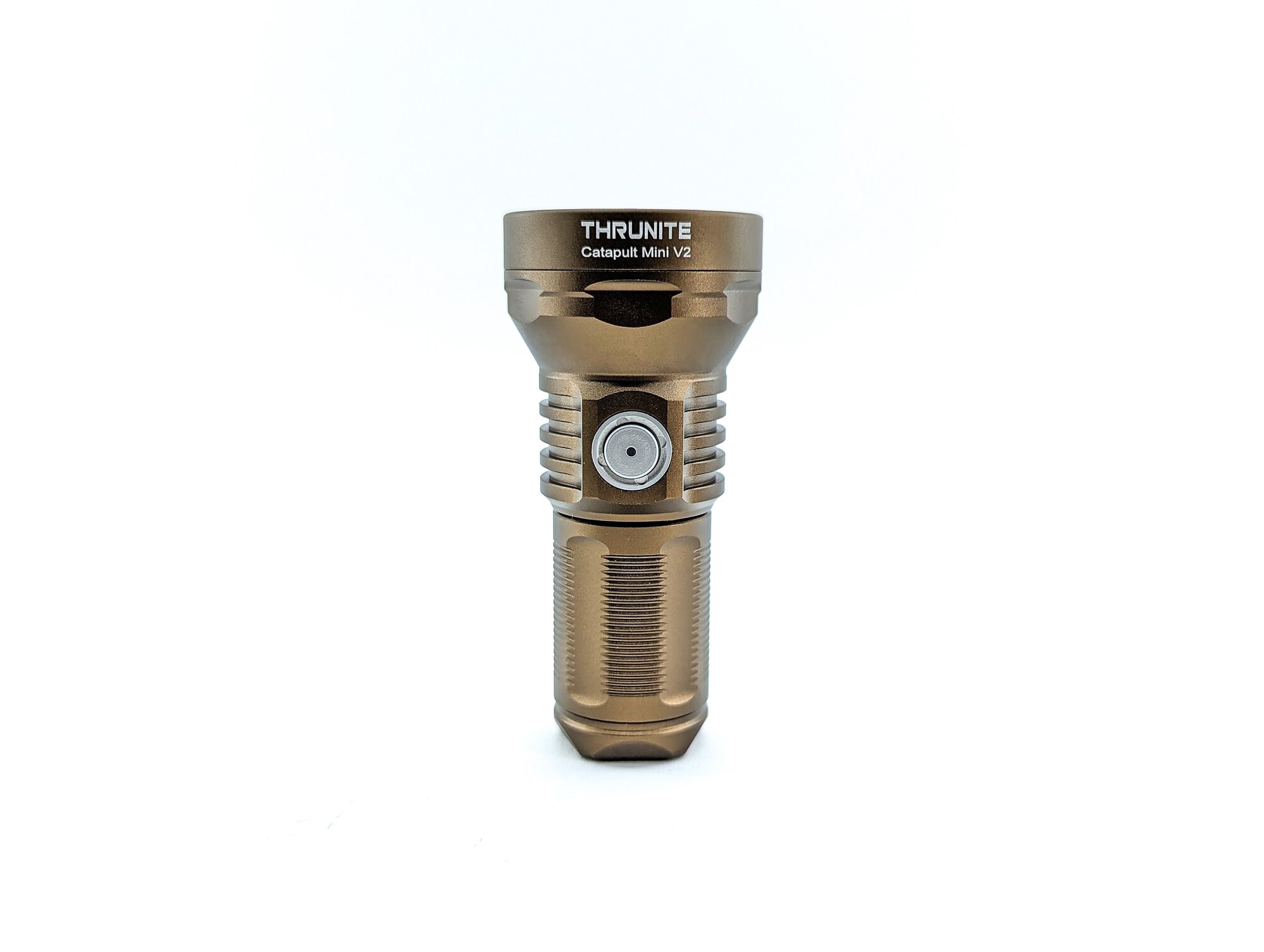
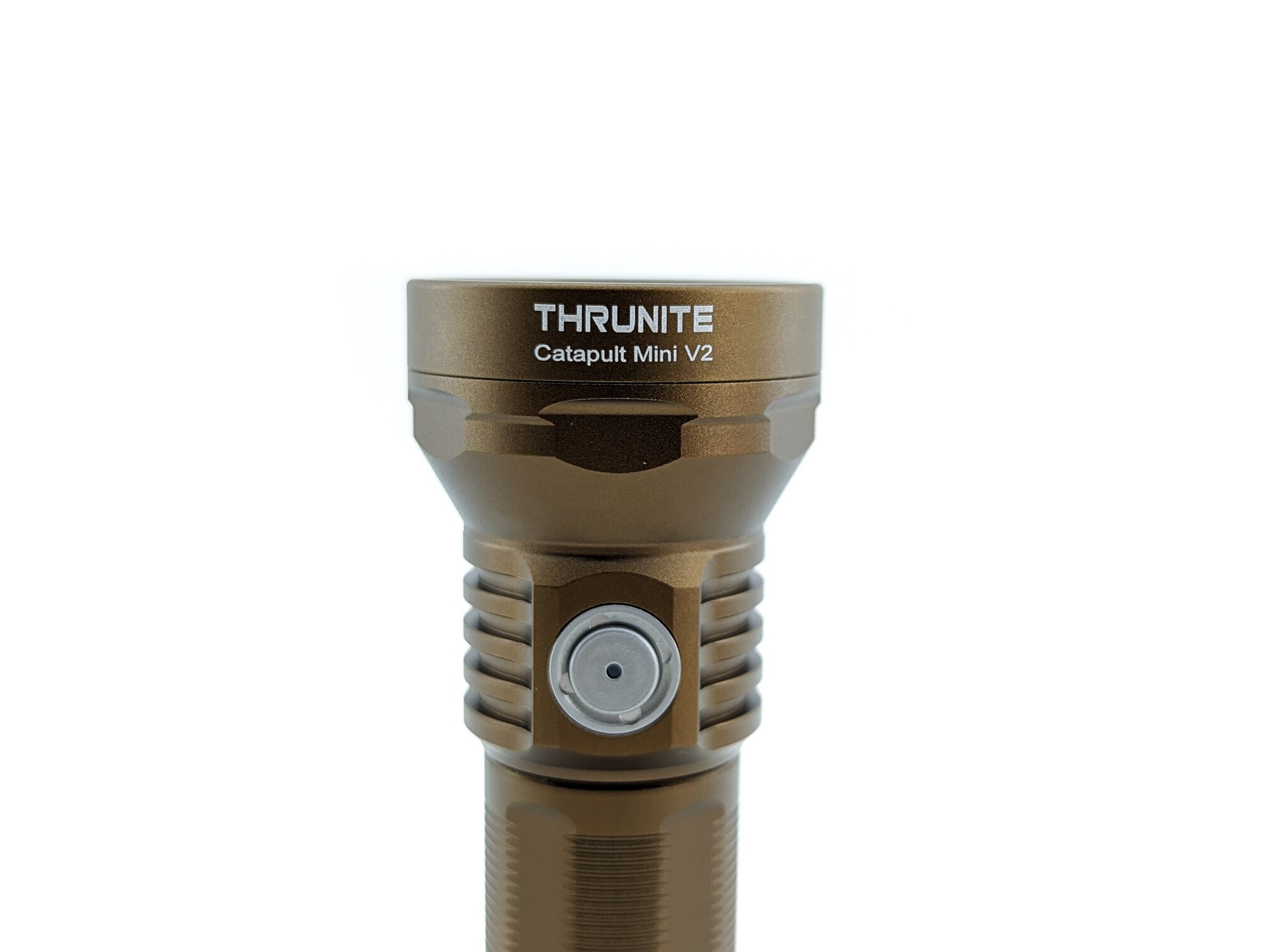
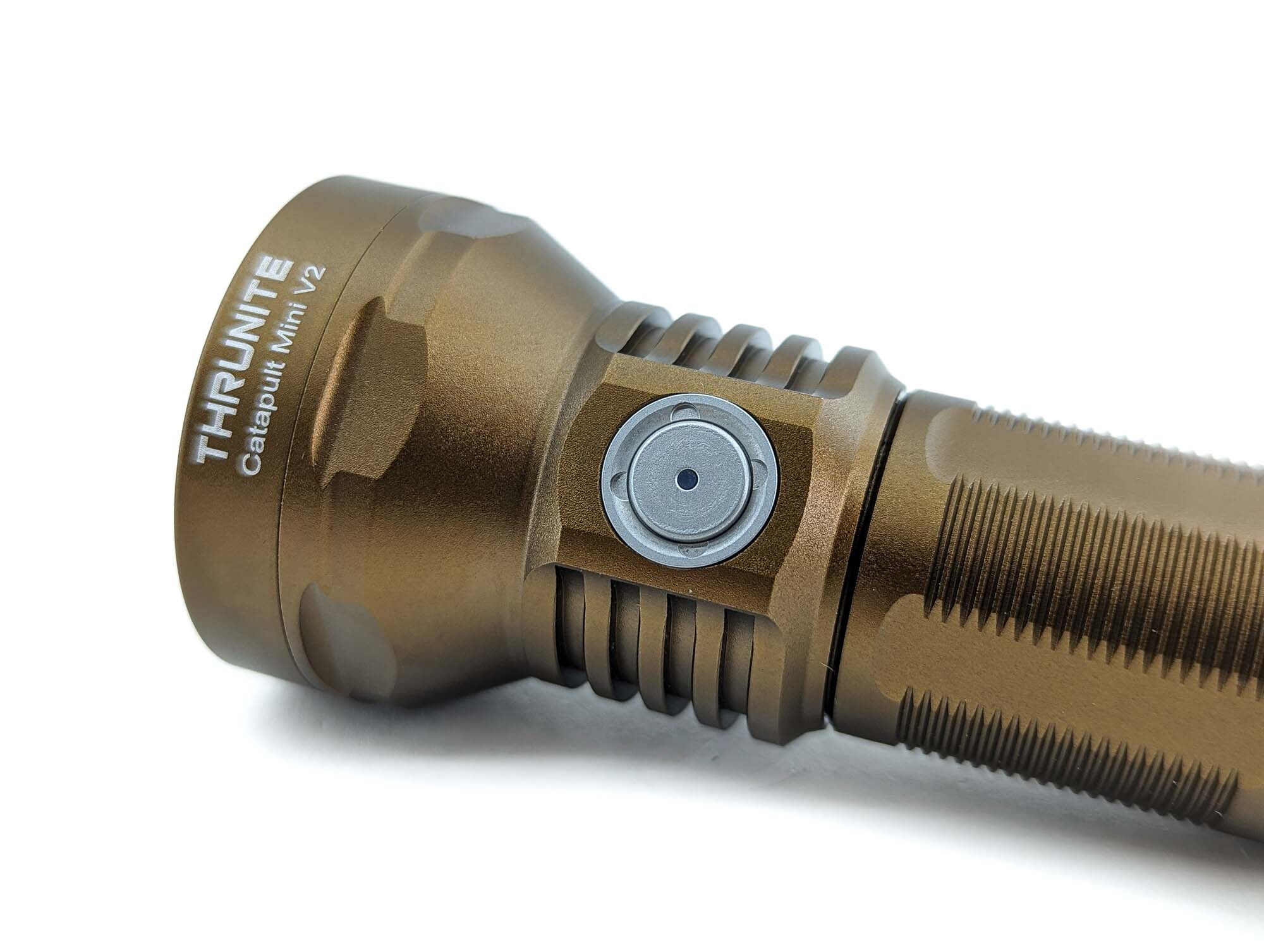
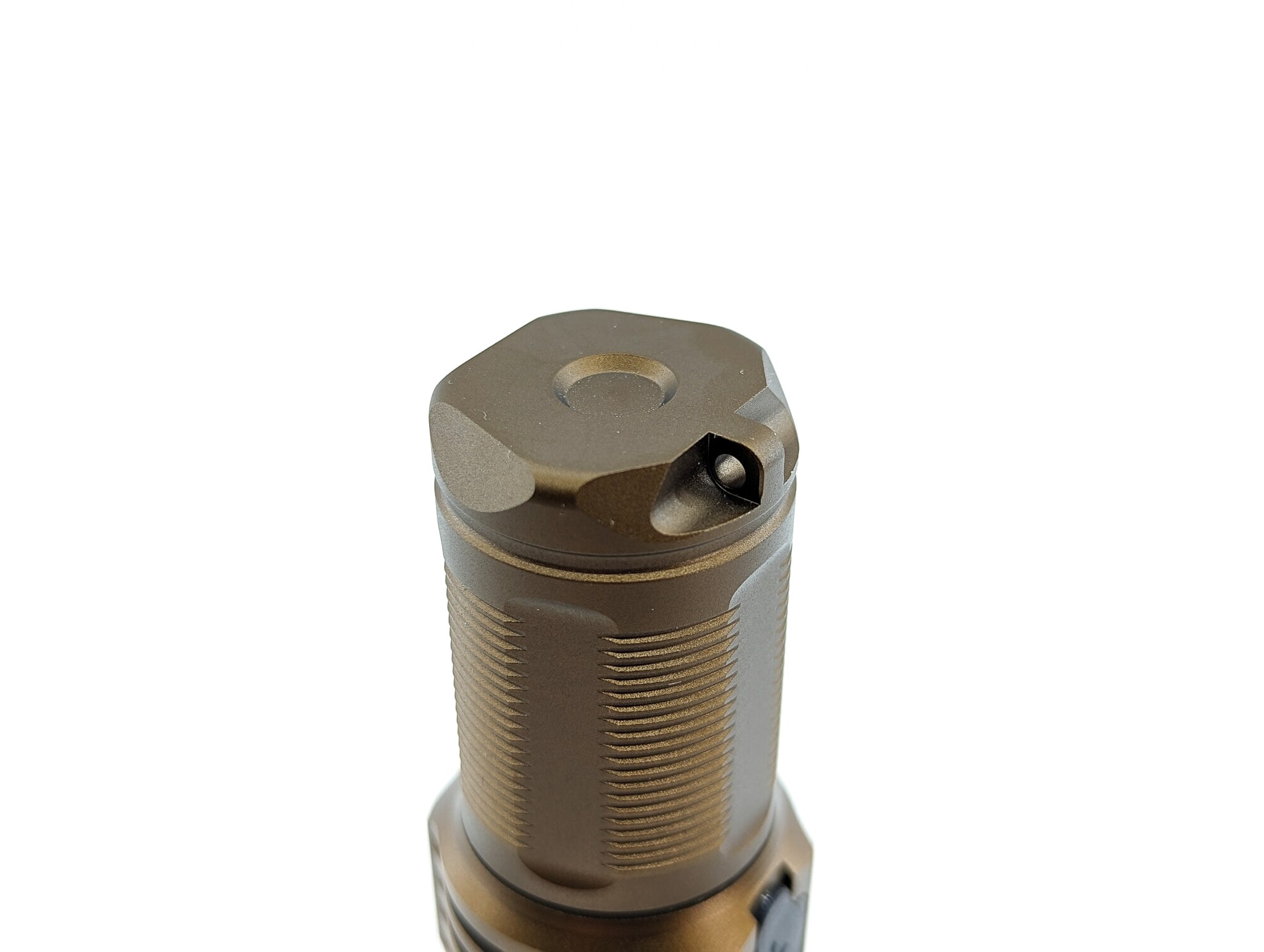
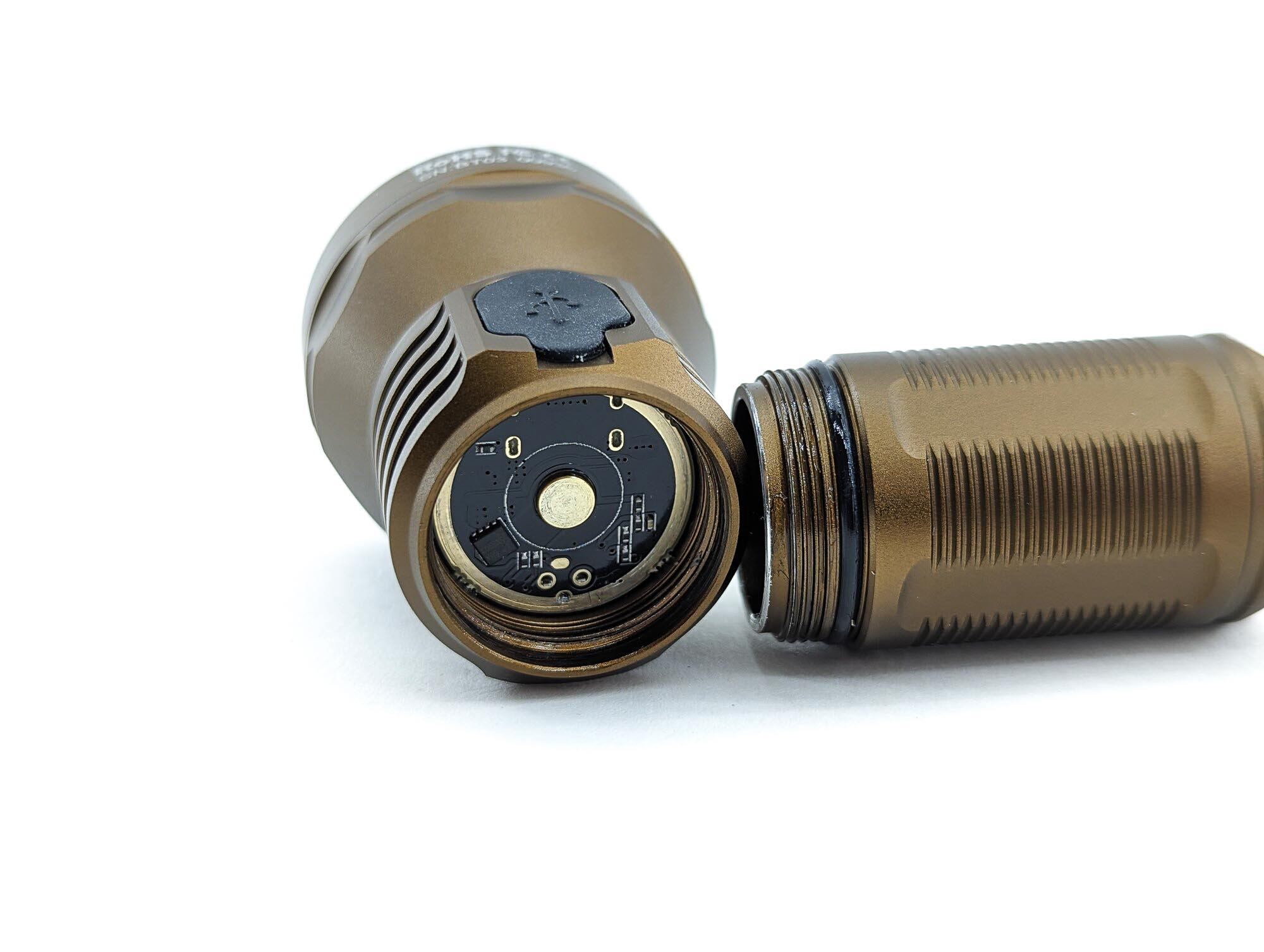
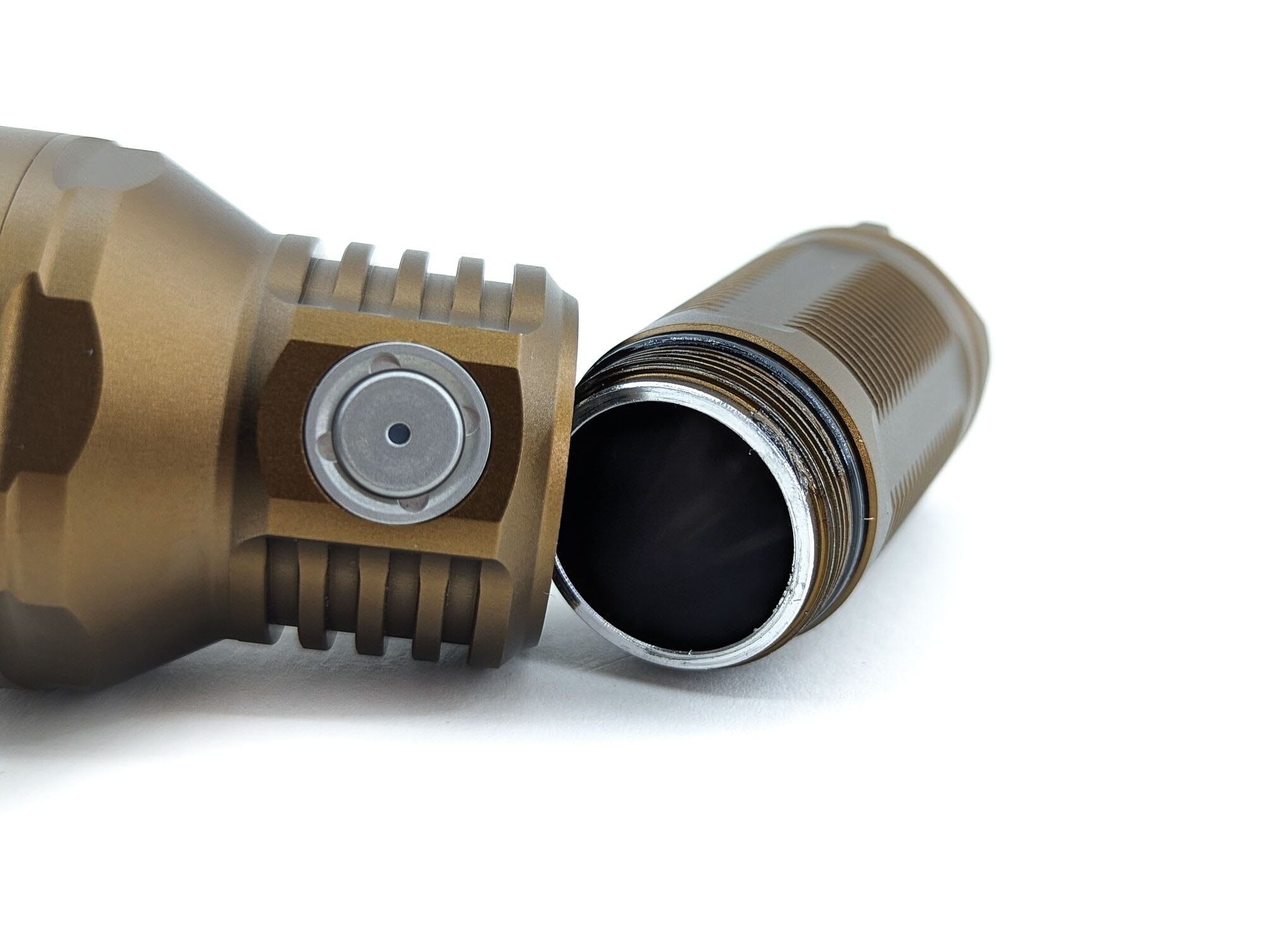
LED, Lens, Bezel, Beam, and Reflector
The original Catapult Mini employed an OSRAM KW.CSLNM1.TG LED behind a TIR optic. The V2 trades those elements for a Luminus SFT40 (domeless) LED and a smooth reflector. With these changes, lumen (specs) output is up 63% while candelas are down 26%. So if you’re looking only for throw, the original might suit your needs a bit better. However, I feel like the Catapult Mini V2 likely has a more usable beam profile for everyday tasks. That is in part due to the very wide spill that surrounds the tight hotspot and moderate corona.
Readings from Opple Light Master, Turbo at 5 meters:
- CCT: 6496K
- CRI: 68.1 Ra
- DUV: +0.0033
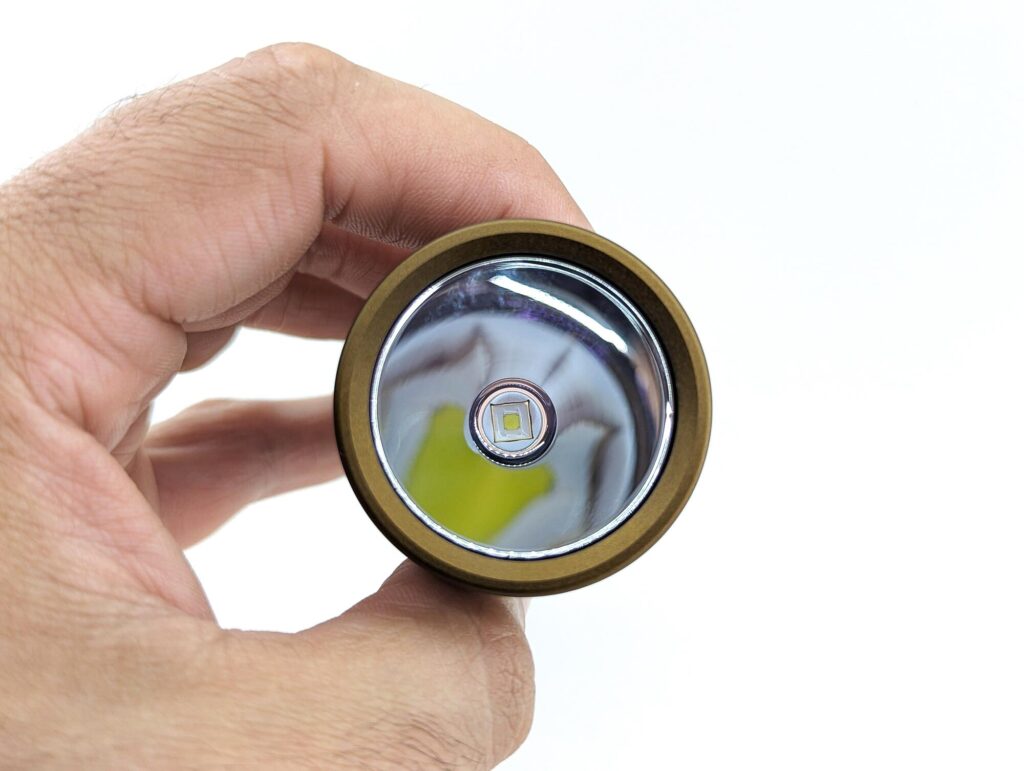
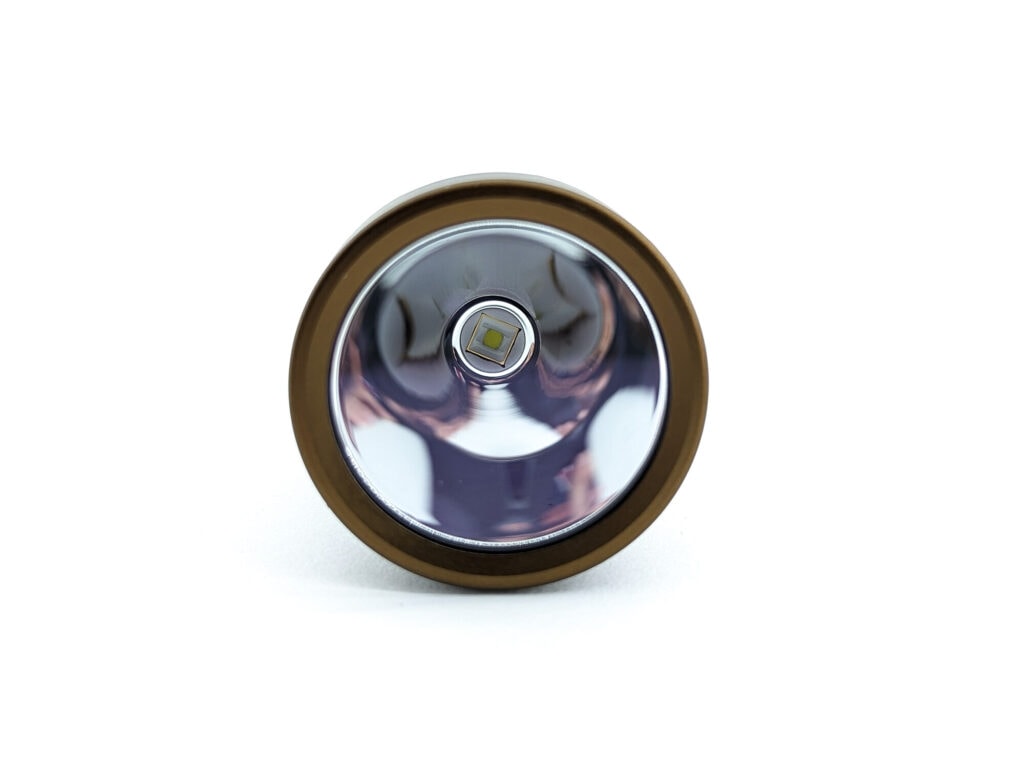
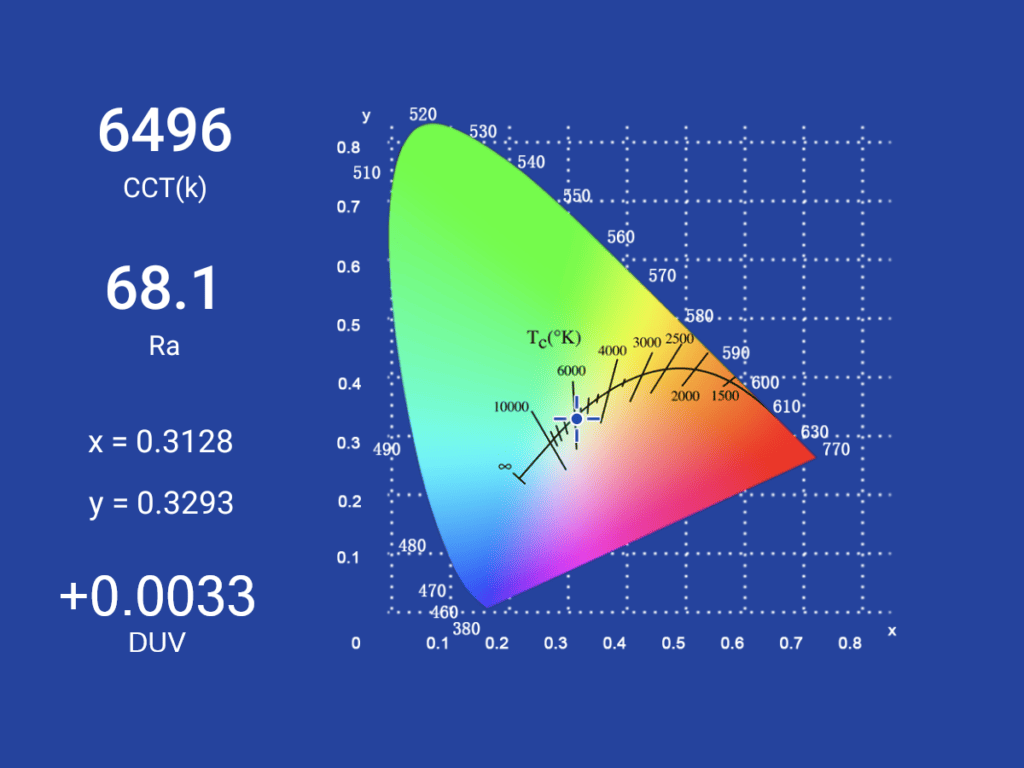
Dimensions and its competition
| ThruNite Catapult Mini V2 | Millimeters | Inches |
|---|---|---|
| Length | 86 mm | 3.4 in |
| Head diameter | 40 mm | 1.6 in |
| Body diameter | 26 mm | 1.0 in |
Dimensions are rounded to the nearest millimeter, and to the nearest tenth of an Inch.
Weight:
| ThruNite Catapult Mini V2 | Weight in grams | Weight in oz |
|---|---|---|
| Without battery: | 89 g | 3.1 oz |
| With battery | 115 g | 4.1 oz |
Weight is rounded to the nearest gram, and to the nearest tenth of an Oz.
Flashlight size comparison with its competition:
Group 1: Lumintop GT3 Mini, ThruNite Catapult Mini V2, ThruNite T1S
Group 2 small thrower flashlights: Manker MC13, ThruNite Catapult Mini V2, Speras M4
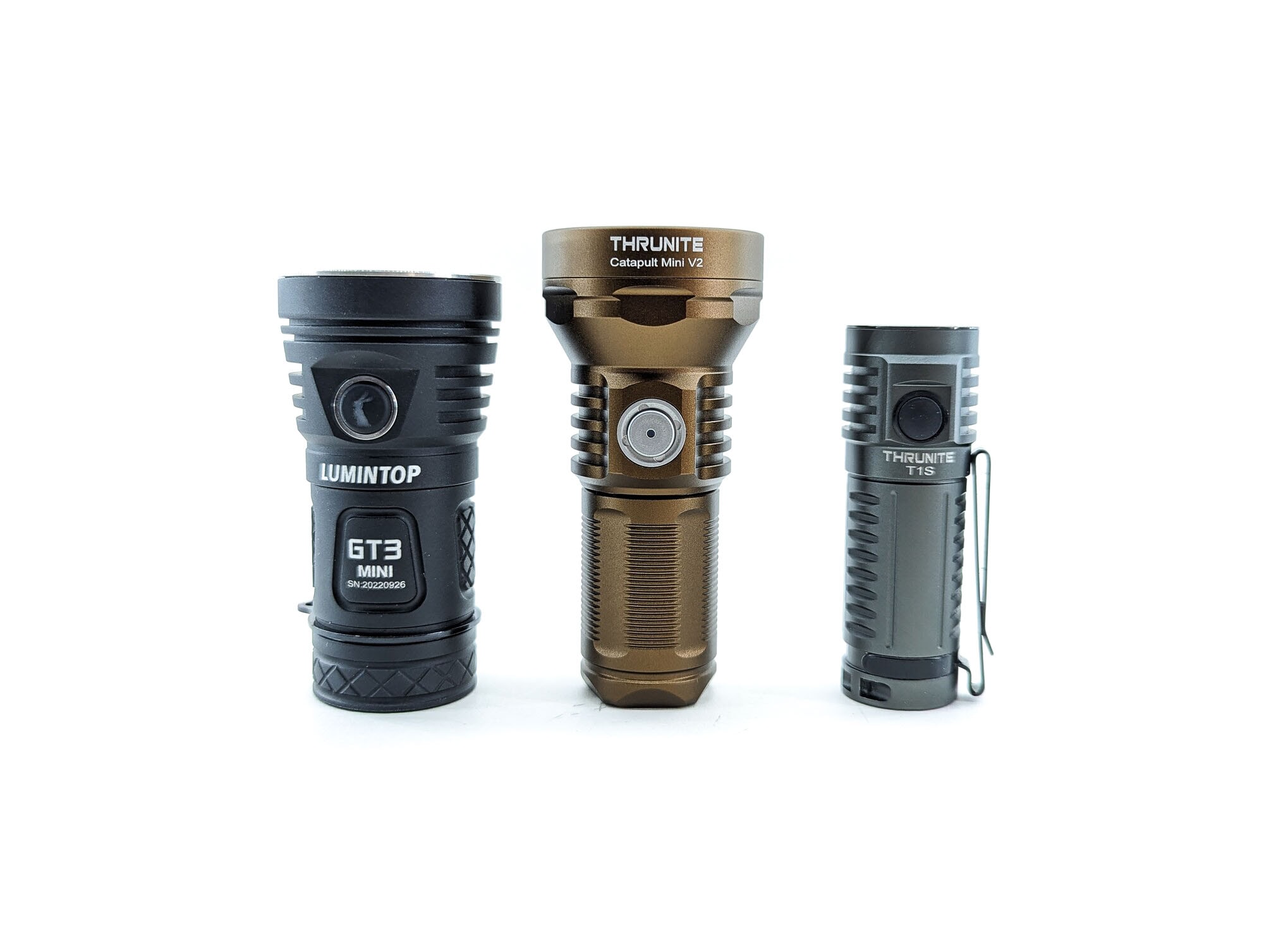
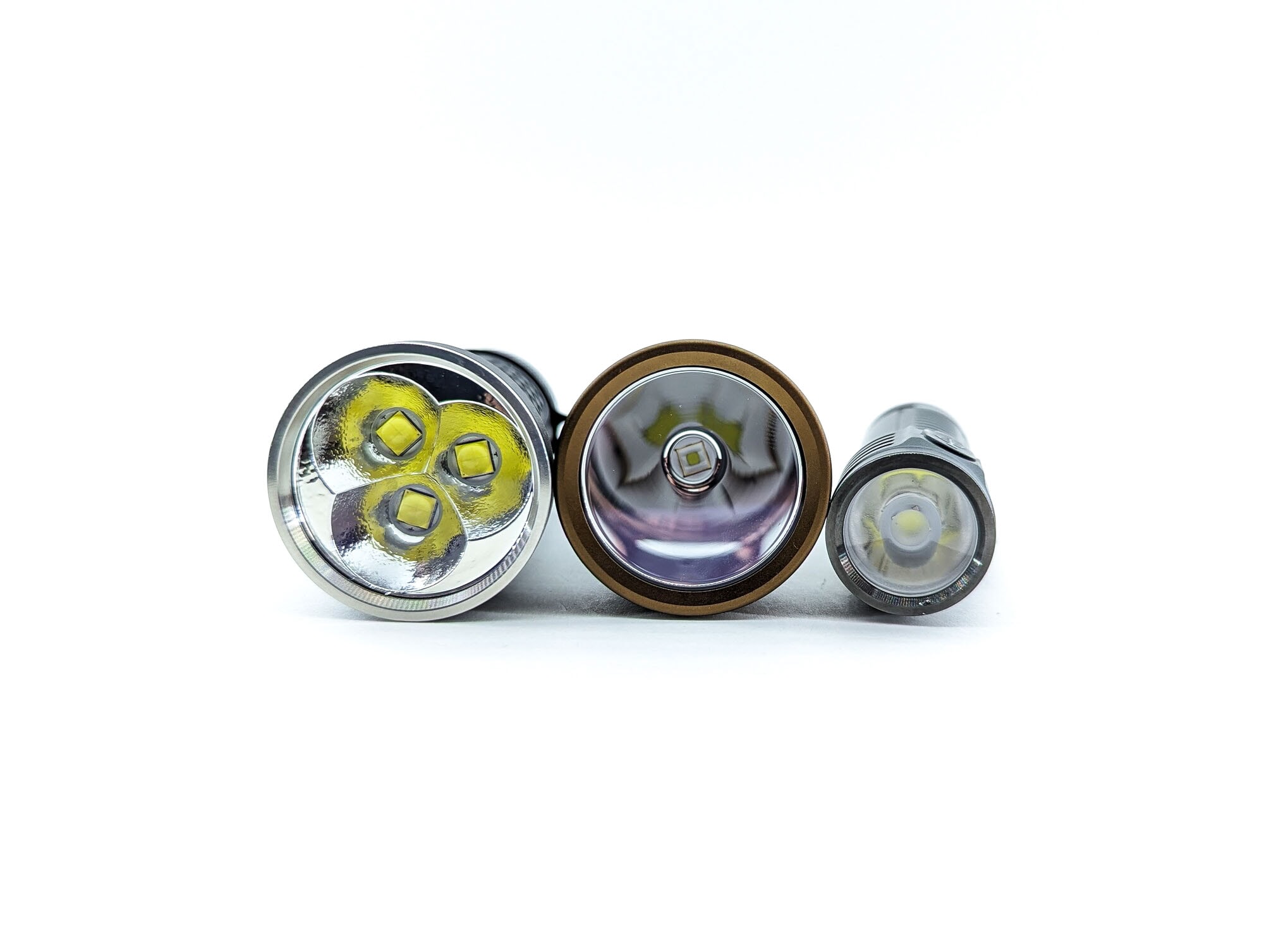
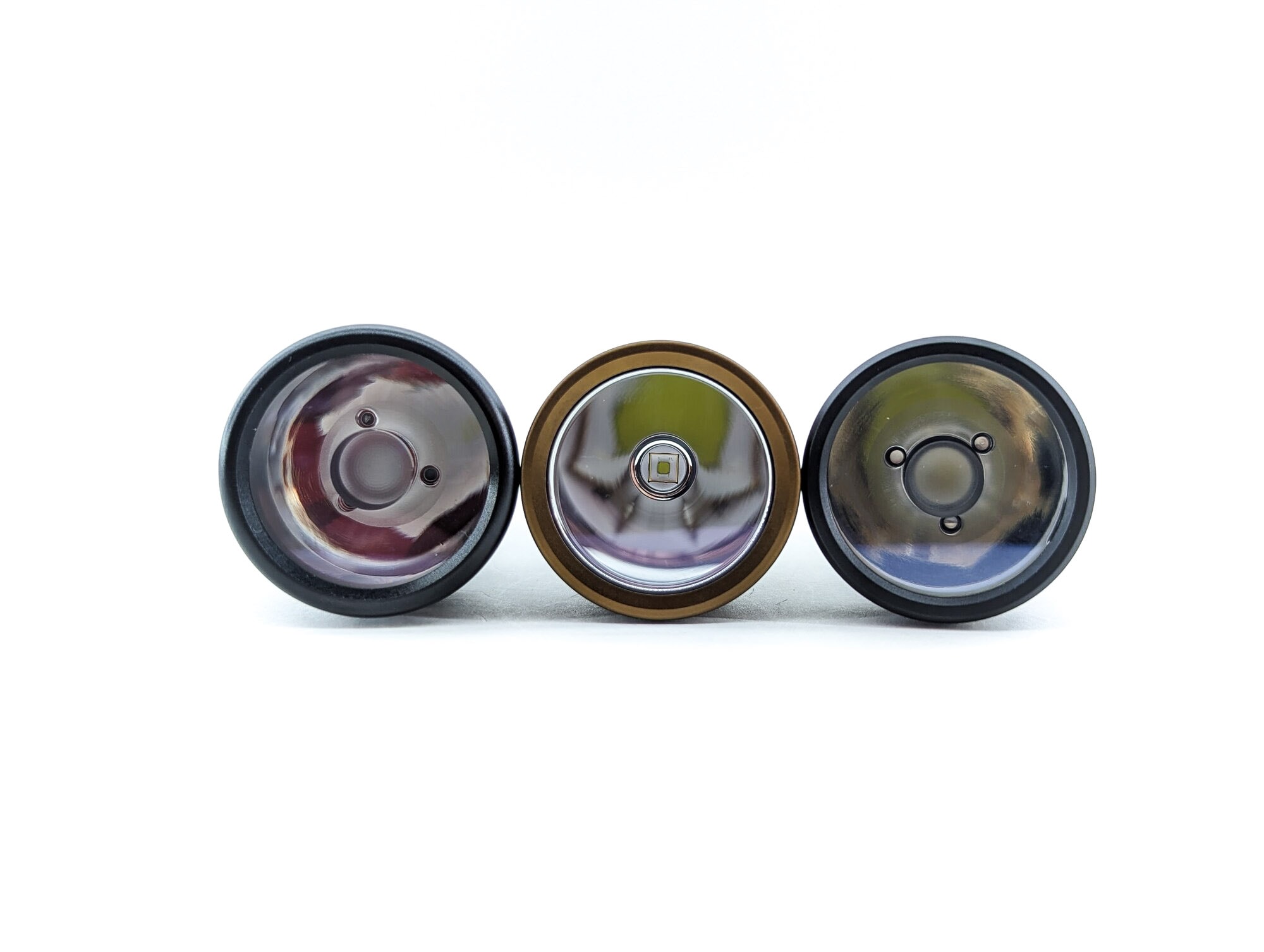
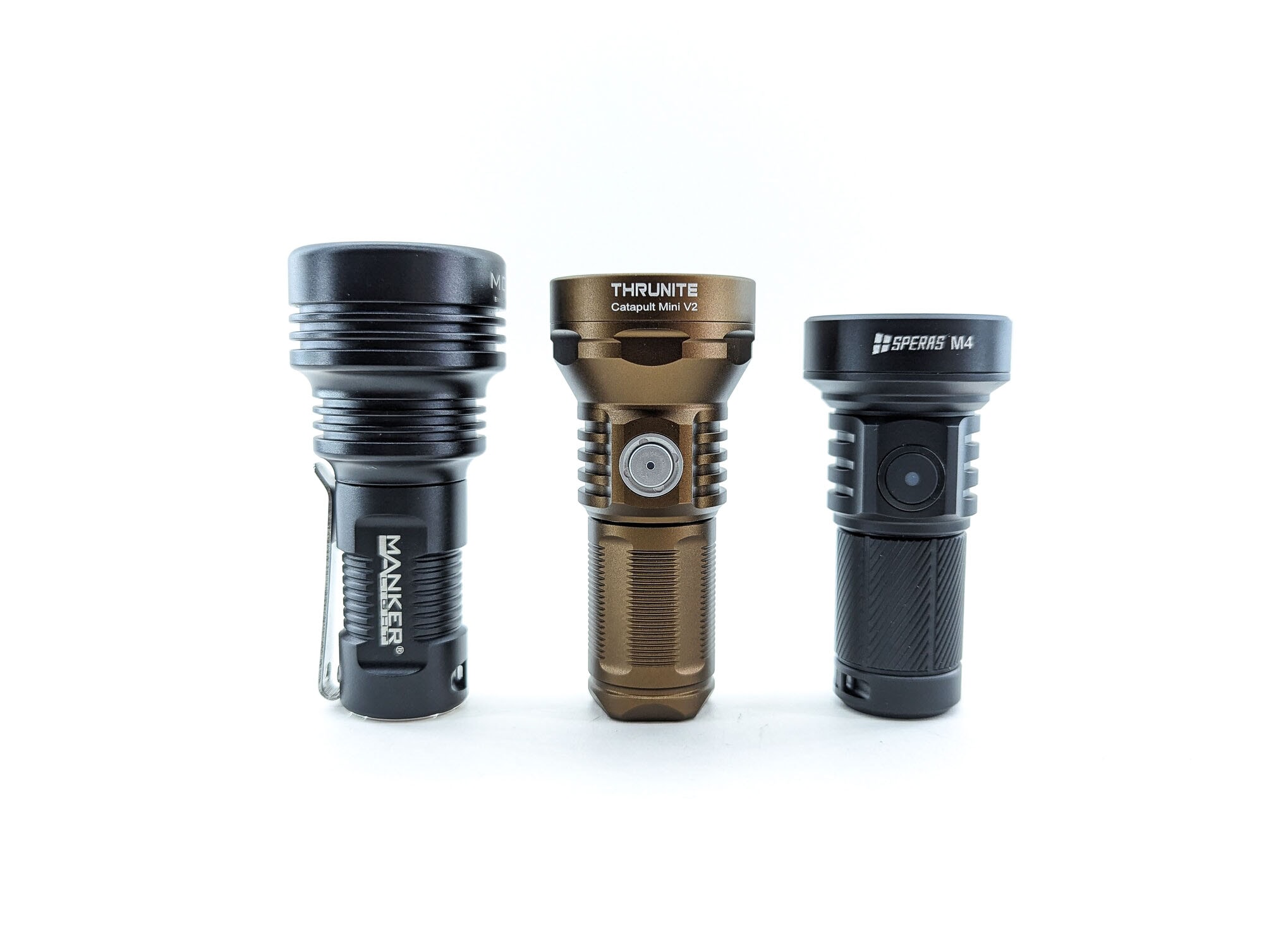
ThruNite Catapult Mini V2 UI: User Interface and Driver
Available modes:
- Turbo, High, Medium, Low, Firefly
Available blinky modes:
- Strobe, Beacon, SOS
From OFF:
- Press and hold: Firefly
- Press and hold 3 seconds: turn on breathing indicator (click to turn off)
- Single click: turn on, last used mode (low, medium, or high)
- Double click: Turbo
- 3 fast clicks: Strobe
- 4 fast clicks: Lockout
From ON:
- Press and hold: change mode (low, medium, high)
- 1 click: turn off
- Double click: Turbo
- 3 fast clicks: Strobe
Mode memory:
- Yes, the last used of Low, Medium, and High is memorized
Shortcuts:
- To Firefly: press and hold from Off
- To Turbo: double click (from Off or On)
- To Strobe: triple click (from Off or On)
Low voltage warning/protection:
- There is an indicator LED in the button that display the remaining battery capacity
- Blue: 21 – 100% (3.3-4.2V)
- Purple: 11 – 20% (3.1-3.3V)
- Red: 1 – 10% (2.8-3.1V)
- Off: 0% (0-2.8V)
Strobe/blinkies
- Triple click from Off or On to activate Strobe
- From Strobe, press and hold to go to Beacon
- From Beacon, press and hold to go to SOS
- Click at any time to turn off
Lock-out mode:
- Click four times from Off to lockout
- Click four times again to unlock
PWM
- No PWM was detected (using a photodiode and a DMM’s frequency mode)
Additional/summary info on the UI:
- I feel like this is a really solid “standard” single e-switch UI with all of the features I want, and pretty much nothing I don’t.
ThruNite Catapult Mini V2 Charging and batteries
The ThruNite Catapult Mini v2 comes with a ThruNite-branded 1100 mAh 18350 battery. It is of the protected variety. The battery looks proprietary, with both the positive button and a negative ring at the “top” of the battery. But in looking at the construction of the Catapult Mini V2, this special battery isn’t needed. I tried using a plain ol’ flat-top unprotected 1100 mAh Epoch 18350 battery and it worked just fine, even though it is considerably shorter. So I’d say this flashlight is very accommodating when it comes to batteries.
I tried doing a little “impact test” against my palm with both the ThruNite battery and the Epoch. With the longer ThruNite battery, solid contact was being made and there was no spring sound, nor did the light flicker. With the shorter, unprotected Epoch battery, however, there was an audible spring sound upon impact and the light flickered, but maintained its current mode and functionality – just a tiny blip.
I don’t really see any specs or details regarding the built-in USB-C charging, aside ThruNite mentioning that the LED indicator is red during charging and turns blue when charging is complete. I observed a charge rate of 3.00 watts (0.59 amps at 5.06 volts). The charge cycle completed in 2 hours and 45 minutes, transferring 6.3 Wh of power (the battery itself is rated at 4 Wh). The resulting battery voltage was 4.18.
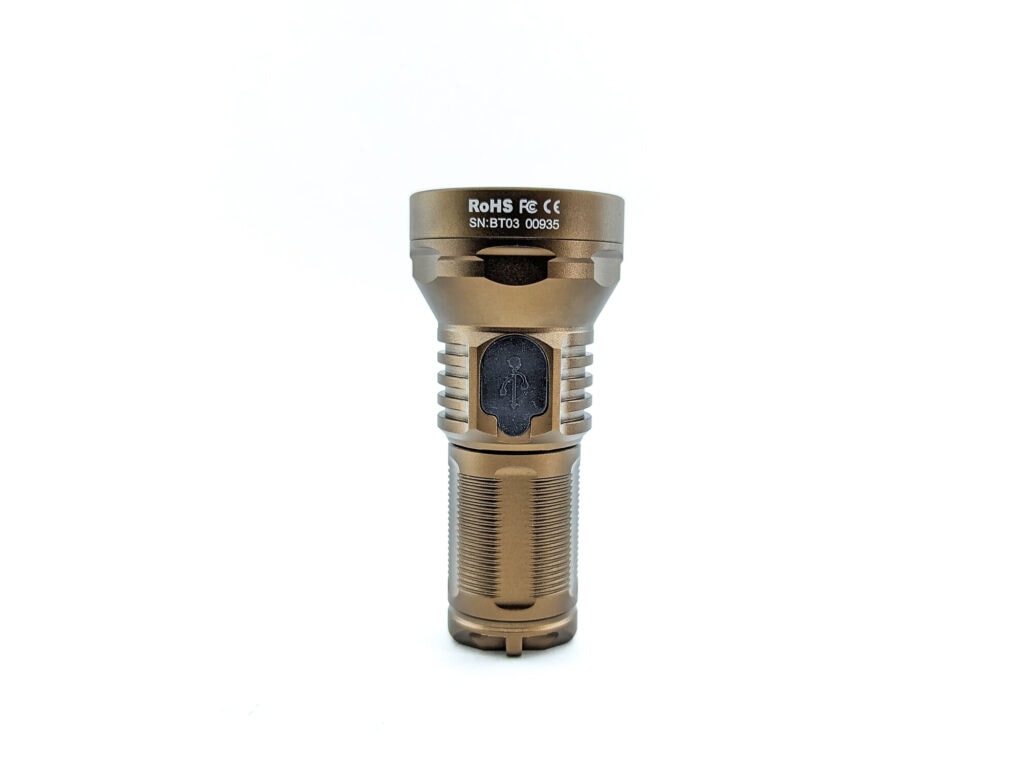

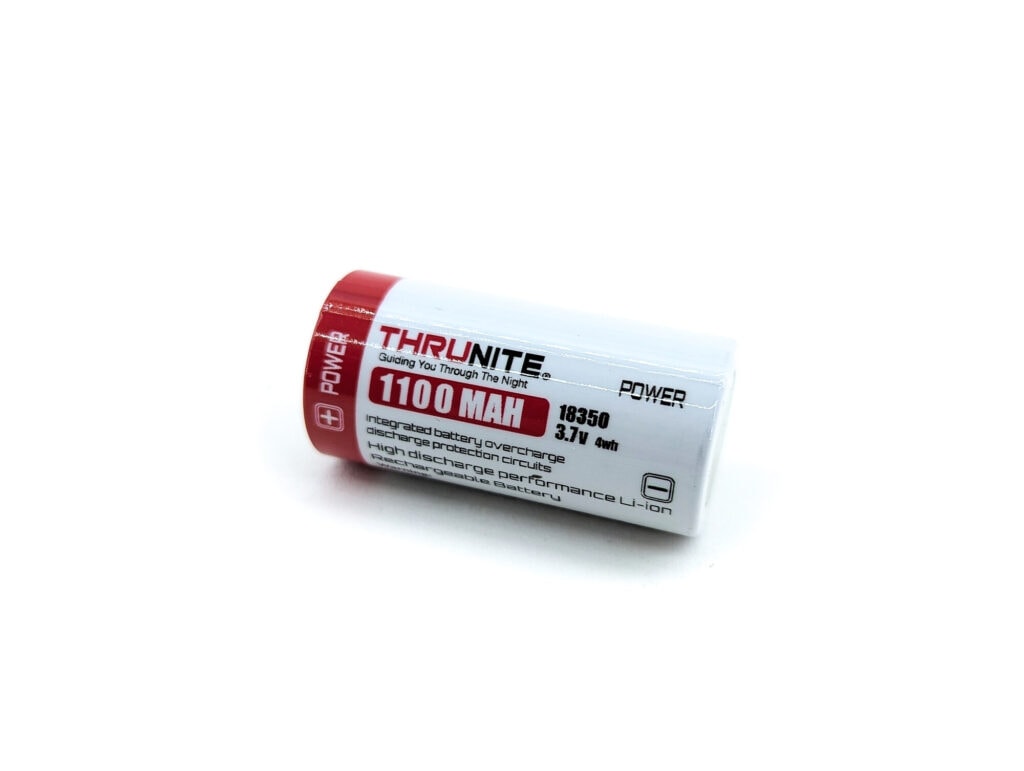
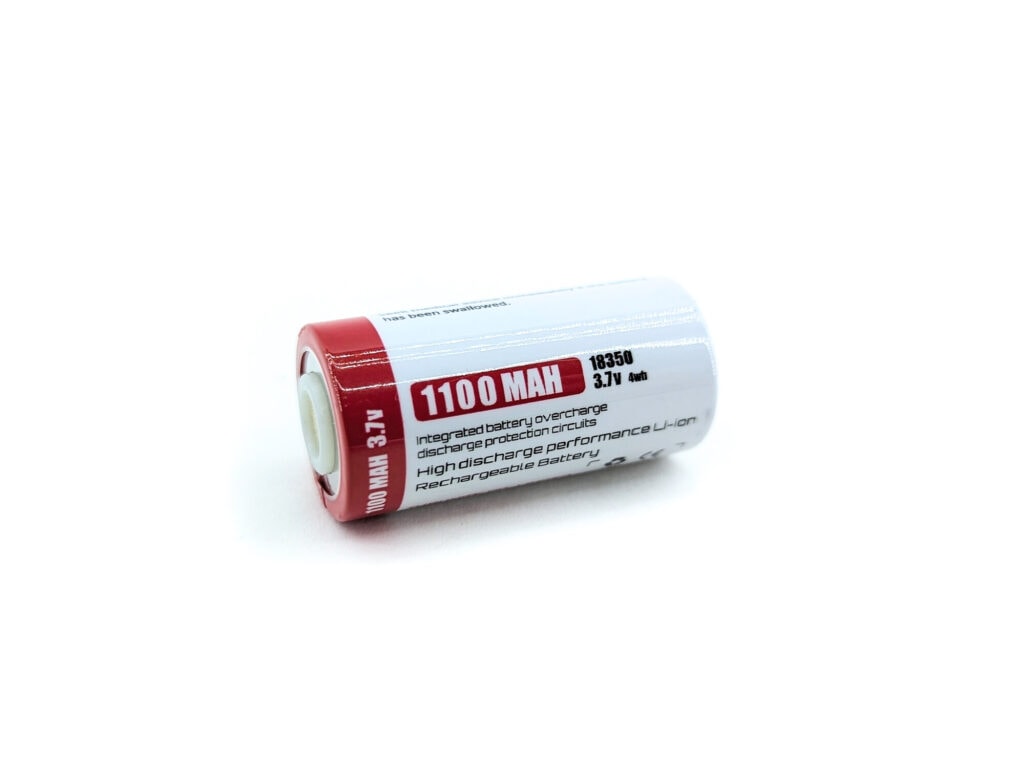
Performance test
Lumen measurements
How Lumens are Measured: Understanding ANSI FL1 Standards How Lumens are Measured: Understanding ANSI FL1 Standards: The ANSI FL1 standards specify that output in lumens should be measured 30 seconds after turning on, as this is the standardized time for measuring brightness according to the industry standard. This is why we focus on this part in our measurements. The ANSI FL1 standards require an ambient temperature of 22 ± 3°C. We record the ambient the ambient temperature to identify potential reasons for any observed discrepancies.Lux was measured by a UNI-T UT383 BT at 10 meters. Lumens were measured in a homemade lumen tube using a VEML7700 sensor, calibrated with a calibration light provided by 1Lumen. The included ThruNite battery was used for testing.
| Mode | Amps at start | Specs | turn on | 30 sec | 10 minutes |
|---|---|---|---|---|---|
| Firefly | 9 mA | 0.6 lm | 0.7 lm | 0.7 lm | – |
| Low | 235 mA | 70 lm | 113 lm | 113 lm | – |
| Med | 413 mA | 160 lm | 244 lm | 244 lm | 246 lm |
| High | 825 mA | 331 lm | 465 lm | 466 lm | 472 lm |
| Turbo | 3.3 A | 1108 > 358 lm | 1391 lm | 1376 lm | 475 lm |
| Turbo at 3.6V | 1288 lm | 1185 lm | – |
Parasitic drain:
- 13 µA
So, what do we see here? The ThruNite Catapult Mini V2 performed exceptionally well. It easily exceeded the lumen specs except for the Firefly mode, which came in right where it should.
ThruNite Catapult Mini V2 Battery Life: Runtime graphs
How Runtimes are Measured: Understanding ANSI FL1 Standards About ANSI FL1 runtime standards: The runtime is measured until the light drops to 10% of its initial output (30 seconds after turning on). This does not mean that the flashlight is not usable anymore. The last column shows how long the light actually works till it shuts off. If there is a + symbol, it means that the test was stopped at that particular point, but the light was actually still running. This happens on certain occasions, with certain drivers, firmware, or batteries.| Mode | Specified runtime | Measured runtime ANSI | Time till shut off |
|---|---|---|---|
| Firefly | 85h | ||
| Low | 6h 36min | ||
| Med | 2h 45min | 2h 51min | 2h 51min |
| High | 1h 8min | 1h 18min | 1h 18min |
| Turbo | 80s + 1h 2min | 1h 15min | 1h 15min |
The runtime measurements fell right inline with spec, if perhaps a bit better. Very close, though. I love seeing results that meet or exceed the manufacturer specs.
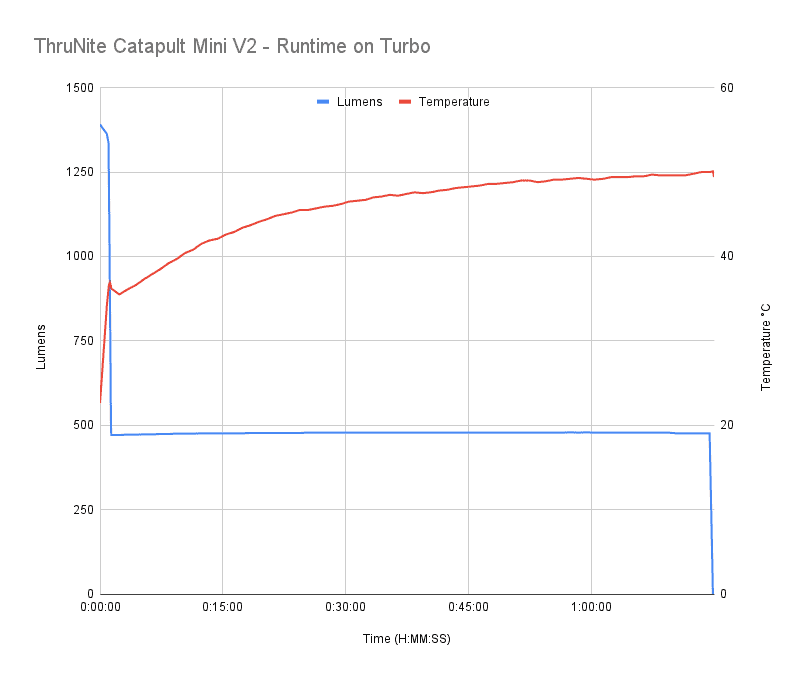
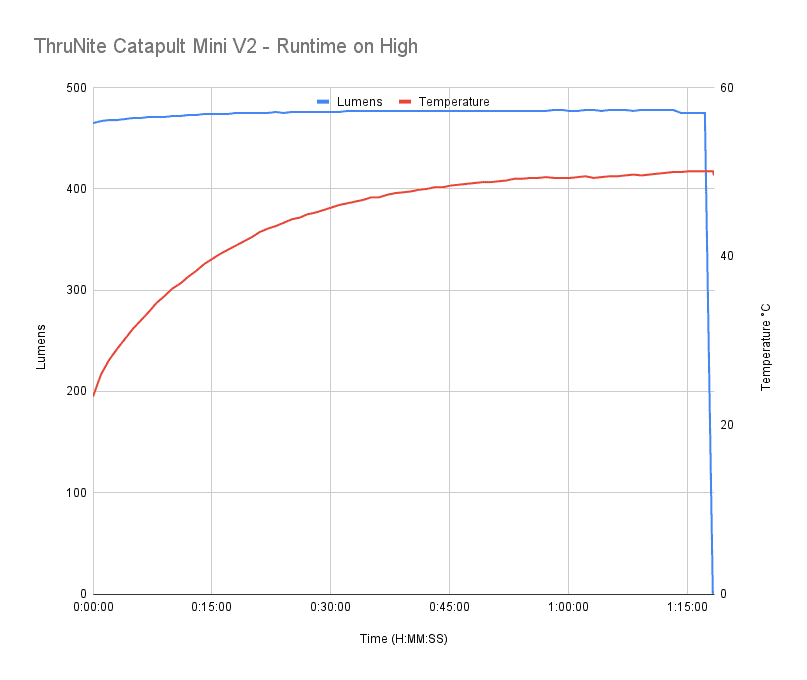
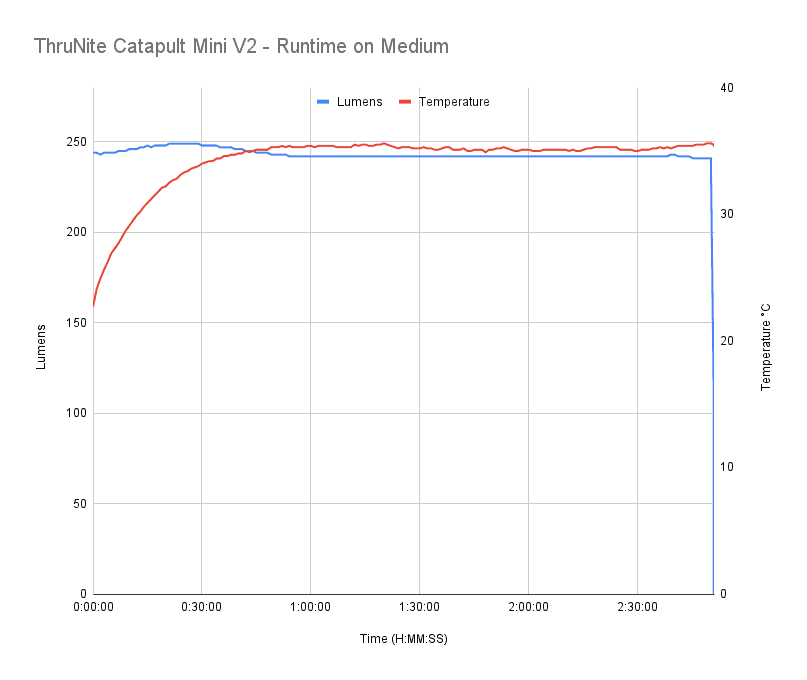
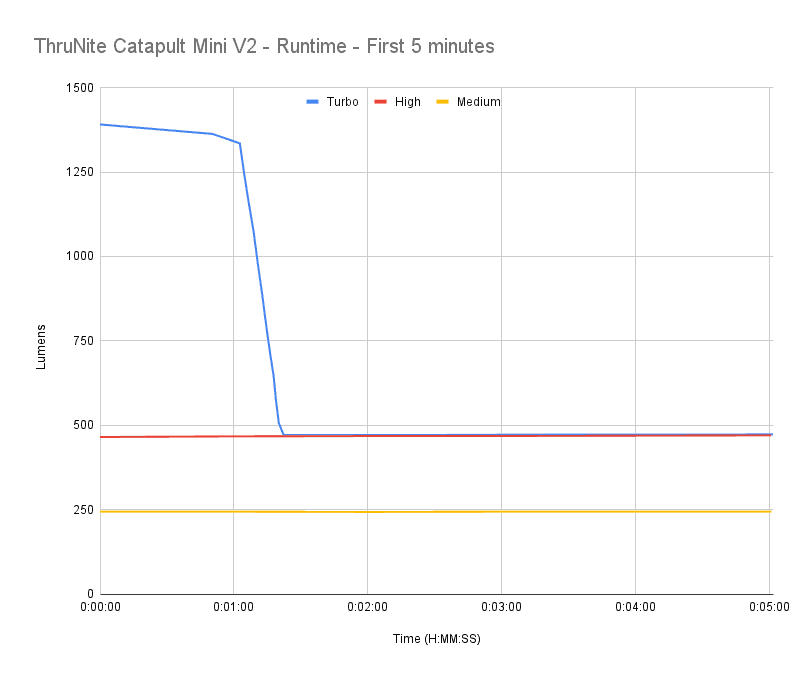
Peak beam intensity and beam distance measurements
About Peak beam intensity: Understanding ANSI FL1 Standards About peak beam intensity The calculated value of distance in meters at which the flashlight produces a light intensity of 0.25 lux. (0.25 lux is about the brightness of a full moon shining on an object). This means that the intensity has decreased so much, it becomes difficult to see darker objects, or objects that don’t reflect light. The columns ‘Meters’ and ‘Yards’ use rounded numbers.Intensity was measured at 10 meters after being turned on for 30 seconds. A UNI-T UT383 BT lux meter was used.
| Mode | Specs | Candela measured | Meters | Yards |
|---|---|---|---|---|
| Low | 8,100 | 180 m | 197 yd | |
| Medium | 14,600 | 242 m | 264 yd | |
| High | 27,600 | 332 m | 363 yd | |
| Turbo | 66,150 cd | 82,000 cd | 573 m | 626 yd |
Again, I’m pleasantly surprised with these measurements. My ThruNite Catapult Mini V2 seems to be hitting over the specs across the board.
Beamshots
Beam shots of the building are taken at 30 m (33 yd) using a Pixel 7 set to ISO 800 with 1/10 second exposure time
Beamshots of the following flashlights compared:
- ThruNite Catapult Mini V2
- Olight Seeker 4 Mini
- Fenix E35R

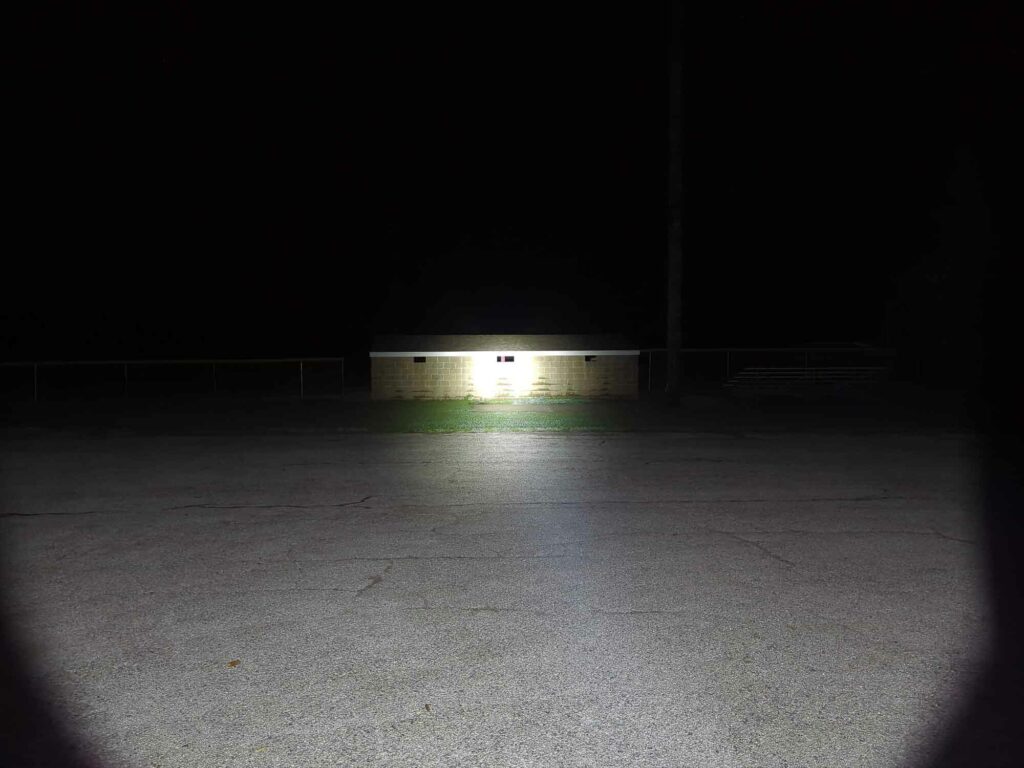

Disclaimer: This flashlight was sent to me for review at no cost by ThruNite. I have not been paid to review, nor have I been holding back on problems or defects.
Final Verdict
Pros
- Powerful little thrower
- Simple but versatile UI
- Sub-lumen level
- Well regulated output
- USB-C charging
- Overall good build quality
Cons
- Large jump from Firefly (0.6 lm) to Low (70 lm)
Explanation on star ratings:
1: Avoid: a match would be a better choice – 2: Poor: significant defect or issues; almost unusable – 3: Average: some defects or issues; but still usable 4: Good: recommended (minor issues) – 5: Great: highly recommended

5 stars: ★★★★★
While our star rating provides a reliable indicator, we encourage you to read the full review to make an informed decision based on your own needs and preferences.
My time with the ThruNite Catapult Mini V2 has been really positive. This little guy packs a serious punch in a small package, and looks good doing it. This ThruNite exceeded nearly every spec and never disappointed. If I had to make one nitpick, I’d say that the mode spacing could use a small tweak (make Low lower). That minor quibble aside, the ThruNite Catapult Mini V2 is an excellent pocket thrower!
Buy your ThruNite Catapult Mini 2 here
1lumen selects and reviews products personally. We may earn affiliate commissions through our links, which help support our testing.